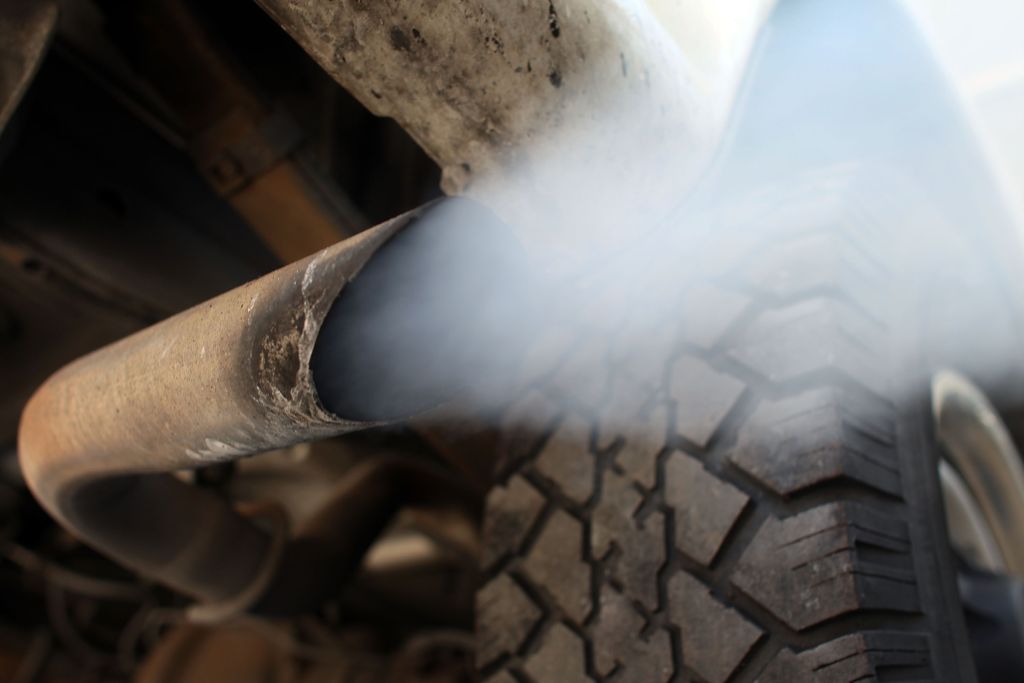New reports shine light on opaque carbon tax program
by Matt Fleming | April 8, 2016 4:52 am

(Photo by Joe Raedle/Getty Images)
As fast as California drivers will spend an extra $2 billion at the pump this year to fund the controversial cap-and-trade program, state lawmakers are finding ways to use it, according to two reports released Thursday.
Cap and trade was implemented by a state regulatory board to try to reduce greenhouse gas emissions to 1990 levels by 2020, as required by law.
One of several additional costs tacked on an estimated 11 cents to each gallon of gas and 13 cents per gallon of diesel, according to the Legislative Analyst’s Office[1], driving average prices to some of the highest in the nation[2].
“Most drivers have no idea that this is costing them $2 billion per year because it has been largely hidden from them,” said Asm. Tom Lackey, R-Palmdale. “It’s clear that we need to improve transparency for consumers about cap and trade’s costs.”
Where does the money go?
Cap-and-trade money is currently appropriated as follows: 40 percent is unallocated, 25 percent is for high-speed rail, 20 percent is for affordable housing and sustainable communities grants, 10 percent is for intercity rail capital projects and 5 percent is for low-carbon transit projects.
Waiting to spend the money are 36 pending proposals in the Legislature totaling $7.5 billion, which is more than double what was proposed in Gov. Jerry Brown’s draft budget, according to a study by the California Tax Foundation[3].
The most expensive proposal is SBX1 2, sponsored by Sen. Bob Huff, R-San Dimas. This bill would divert $1.9 billion annually to street and highway construction projects and block further cap-and-trade funds from going to high-speed rail.
In addition to barring further funds from going to high-speed rail (a recurring theme[4] for Huff), the Huff bill is too vague to show whether it will reduce GHGs or not and may “leave itself open to litigation,” according to the legislative analysis.[5]
Another bill, sponsored by Asm. Jimmy Gomez, D-Los Angeles, would fund nearly $1 billion worth of projects, including up to $100 million on new toilets. According to the report, many of the initiatives would likely reduce GHG emissions, while other parts of the bill might not.
Other bills include synchronizing traffic lights, implementing a car buyback program, promoting recycled glass and preventing forest fires. And while its unclear what effect most of the proposals would have on GHG emissions, the report was issued to help voters and legislators make that determination.
“This report identifies the auction revenue spending proposals that are active in the Legislature, so they can be given proper scrutiny,” California Tax Foundation Director Robert Gutierrez said in a statement.
Legality
Opponents of the program argue that by collecting revenue from drivers and businesses (those with large GHG emissions) it amounts to an illegal tax, which would have needed to be approved by a two-thirds legislative majority to be legal. A previous court ruling — which is now being challenged — found that the revenue is OK as a regulatory fee and thereby not subject to a two-third’s vote.
In 2006, the Legislature passed AB32[6], which tasked the state ARB to implement the GHG reduction. Proponents say this mandate gave the ARB the legal authority to auction off emission allowances (there’s a “cap” on emissions and business can “trade” them at auction).
In January, the non-partisan Legislative Analyst’s Office recommended[7] lawmakers either narrowly tailor their proposals to unquestionably reduce GHGs or approve the program with a two-thirds majority to avoid legal complications.
- Legislative Analyst’s Office: https://ad36.asmrc.org/sites/default/files/districts/ad36/files/2016%20LAO%20Cap%20and%20Trade%20Cost%20Estimates.pdf
- highest in the nation: http://money.cnn.com/news/storysupplement/economy/gas_prices_by_state/
- California Tax Foundation: http://www.caltaxfoundation.org/reports/2016_Cap_and_Trade_Report.pdf
- a recurring theme: http://calwatchdog.com/2016/02/23/ballot-initiative-pits-water-high-speed-rail/
- the legislative analysis.: http://leginfo.legislature.ca.gov/faces/billAnalysisClient.xhtml?bill_id=201520161SB2
- AB32: http://www.arb.ca.gov/cc/ab32/ab32.htm
- recommended: http://lao.ca.gov/reports/2016/3328/cap-trade-revenues-012116.pdf
Source URL: https://calwatchdog.com/2016/04/08/new-reports-shine-light-opaque-cap-trade-program/